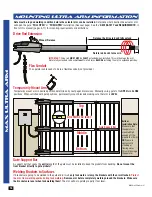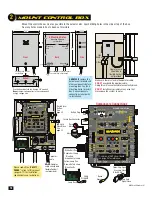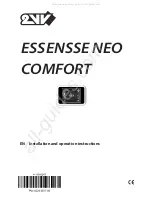
4
MAX Arm/Ultra Arm V1
Vehicular gates should be installed in accordance with ASTM F2200: Standard Specification for Automated Vehicular Gate Construction. For a copy, contact
ASTM directly at 610-832-9585 or www.astm.org.
GATE CONSTRUCTION INFORMATION
BEFORE attempting to install, operate or maintain the operator, you must read and fully understand this manual and follow ALL safety instructions.
DO NOT attempt repair or service of your gate operator unless you are an Authorized Service Technician.
important
Gates shall be constructed in accordance with the provisions given for the appropriate gate type listed, refer to ASTM F2200 for additional gate types.
Gates shall be designed, constructed and installed to not fall over more than 45 degrees from the vertical plane, when a gate is detached from the supporting
hardware.
Gates shall have smooth bottom edges, with vertical bottom edged protrusions not exceeding 0.50 inches (12.7 mm) when other than the exceptions listed in
ASTM F2200.
The minimum height for barbed tape shall not be less than 8 feet (2.44 m) above grade and for barbed wire shall not be less than 6 feet (1.83 m) above grade.
An existing gate latch shall be disabled when a manually operated gate is retrofitted with a powered gate operator.
A gate latch shall not be installed on an automatically operated gate.
Protrusions shall not be permitted on any gate, refer to ASTM F2200 for Exceptions.
Gates shall be designed, constructed and installed such that their movement shall not be initiated by gravity when an automatic operator is disconnected, in
accordance with the following.
Vehicular horizontal slide gate. Shall not result in continuous, unimpeded movement in either lineal direction of its travel.
Vehicular horizontal swing gate. Shall not result in continuous, unimpeded movement in either direction along the arc of its path of travel.
For pedestrian access in the vicinity of an automated vehicular gate, a separate pedestrian gate shall be provided. The pedestrian gate shall be installed in a
location such that a pedestrian shall not come in contact with a moving vehicular access gate. A pedestrian gate shall not be incorporated into an automated
vehicular gate panel.
Any existing automated gate, when the operator requires replacement, shall be upgraded to conform to the provisions of this specification in effect at that time.
Vehicular horizontal slide gate:
All weight bearing exposed rollers 8 feet (2.44 m), or less, above grade shall be guarded or covered.
All openings shall be designed, guarded, or screened from the bottom of the gate to the top of the gate or a minimum of 72 in. (1.83 m) above grade, whichever
is less, to prevent a 2 1⁄4 in. (57 mm) diameter sphere from passing through the openings anywhere in the gate, and in that portion of the adjacent fence that
the gate covers in the open position. The gate panel shall include the entire section of the moving gate,including any back frame or counterbalance portion of
the gate.
A gap, measured in the horizontal plane parallel to the roadway, between a fixed stationary object nearest the roadway, (such as a gate support post) and the
gate frame when the gate is in either the fully open position or the fully closed position, shall not exceed 2 1/4 inches (57 mm), refer to ASTM F2200 for
Exception.
Positive stops shall be required to limit travel to the designed fully open and fully closed positions. These stops shall be installed at either the top of the gate, or
at the bottom of the gate where such stops shall horizontally or vertically project no more than is required to perform their intended function.
All gates shall be designed with sufficient lateral stability to assure that the gate will enter a receiver guide, refer to ASTM F2200 for panel types.
The following provisions shall apply to Class IV vehicular horizontal slide gates:
All weight bearing exposed rollers 8 feet (2.44 m), or less, above grade shall be guarded or covered.
Positive stops shall be required to limit travel to the designed fully open and fully closed positions. These stops shall be installed at either the top of the gate, or
at the bottom of the gate where such stops shall horizontally or vertically project no more than is required to perform their intended function.
Vehicular horizontal swing gate:
Gates shall be designed, constructed and installed so as not to create an entrapment area between the gate and the supporting structure or other fixed object
when the gate moves toward the fully open position.
The width of an object (such as a wall, pillar or column) covered by a swing gate when in the open position shall not exceed 4 inches (102 mm), measured
from the center line of the pivot point of the gate, refer to ASTM F2200 for exception.
The distance between a fixed object such as a wall, pillar or column, and a swing gate when in the open position shall not be less than 16 inches (406 mm),
refer to ASTM F2200 for exception.
ONLY Class IV vehicular horizontal swing gates shall be designed, constructed and installed in accordance with security related parameters specific to the
application.
GENERAL REQUIREMENTS
Содержание MAX ARM
Страница 2: ......







































